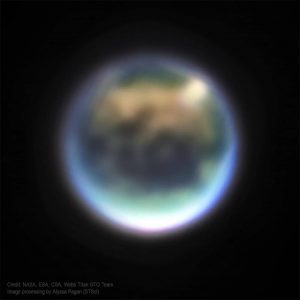What can JWST see?
The Endeavour 2024-04-28
The other day I ran across this photo of Saturn’s moon Titan taken by the James Webb Space Telescope (JWST).
If JWST can see Titan with this kind of resolution, how well could it see Pluto or other planets? In this post I’ll do some back-of-the-envelope calculations, only considering the apparent size of objects, ignoring other factors such as how bright an object is.
The apparent size of an object of radius r at a distance d is proportional to (r/d)². For more details, see the post Solid angle of a star.
Of course the JWST isn’t located on Earth, but JWST is close to Earth relative to the distance to Titan.
Titan is about 1.4 × 1012 meters from here, and has a radius of about 2.6 × 106 m. Pluto is about 6 × 1012 m away, and has a radius of 1.2 × 106 m. So the apparent size of Pluto would be around 90 times smaller than the apparent size of Titan. Based on only the factors considered here, JWST could take a decent photo of Pluto, but it would be lower resolution than the photo of Titan above, and far lower resolution than the photos taken by New Horizons.
Could JWST photograph an exoplanet? There are two confirmed exoplanets are orbiting Proxima Centauri 4 × 1016 m away. The larger of these has a mass slightly larger than Earth, and presumably has a radius about equal to that of Earth, 6 × 106 m. Its apparent size would be 150 million times smaller than Titan.
So no, it would not be possible for JWST to photograph an expolanet.
The post What can JWST see? first appeared on John D. Cook.